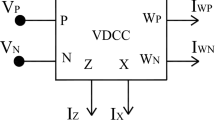Abstract
This paper presents a new mutually coupled circuit (MCC) based on voltage differencing current conveyor (VDCC). The proposed MCC has been designed using the Gorski-Popiel technique. The proposed circuit consists of two VDCCs as active elements, three resistors, and two grounded capacitors as passive elements. The primary and secondary self-inductances and the mutual inductance can be controlled independently and can be adjusted electronically by the bias current of the VDCCs. There is only one matching condition for satisfying symmetrical coupling. Time and frequency-domain analyses have been performed with the LTspice program to verify the theoretical analyses. A double-tuned band-pass filter application is given to show the functionality of the proposed MCC.

















Similar content being viewed by others
Data availability statement
The datasets generated during and/or analyzed during the current study are available from the corresponding author on reasonable request.
References
Atiya, F. (1978). The composite active filter: A combined wave-active and gyrator-C filter. IEEE Transactions on Circuits Systems, 25, 573–579. https://doi.org/10.1109/TCS.1978.1084517
Soderstrand, M. (1978). Active R ladders: High frequency, high order, low sensitivity active R filters without external capacitors. IEEE Transactions on Circuits Systems, 25, 1032–1038. https://doi.org/10.1109/TCS.1978.1084416
Higashimura, M., & Fukui, Y. (1985). Realization of new mutually coupled circuits using mutators. International Journal of Electronics, 58, 477–485. https://doi.org/10.1080/00207218508939044
Higashimura, M., & Fukui, Y. (1991). Electronically tunable OTA-C mutually coupled circuit. Electronics Letters, 27, 1251. https://doi.org/10.1049/el:19910784
Higashimura, M., & Fukui, Y. (1991). RC active realization of mutually coupled circuit. In IEEE International sympoisum circuits systems (vol. 3, pp. 1343–1346). IEEE. https://doi.org/10.1109/ISCAS.1991.176619.
Shigehiro, T., Nakamura, M., & Yoneda, S. (1991). A simulation of high-frequency mutually coupled circuit using bipolar transistors. Electron Commun Japan (Part II Electron), 74, 74–83. https://doi.org/10.1002/ecjb.4420740908
Nakamura, M., Okine, M., Shigehiro, T., & Unehara, T. (1996). A synthesis of an LC simulation-Type double-tuned circuit adjustable by a single parameter. Electron Commun Japan (Part II Electron), 79, 66–75. https://doi.org/10.1002/ecjb.4420791109
Taher Abuelma’atti, M., Muhammad Al-Shahrani, S., & Kulaib Al-Absi, M. (2005). Simulation of a mutually coupled circuit using plus-type CCIIs. International Journal of Electronics, 92, 49–54. https://doi.org/10.1080/00207210512331337749
Yuce, E., Minaei, S., & Ibrahim, M. A. (2007). A new simulation of mutually coupled circuit based on CCIIs. International Journal of Electronics, 94, 367–372. https://doi.org/10.1080/00207210701292779
Yuce, E., & Minaei, S. (2007). A New active network suitable for realizing ladder filters and transformer simulator. Journal of Circuits, Systems and Computers, 16, 29–41. https://doi.org/10.1142/S021812660700354X
Yuce, E., & Minaei, S. (2008). Electronically tunable simulated transformer and its application to stagger-tuned filter. IEEE Transactions on Instrumentation and Measurement, 57, 2083–2088. https://doi.org/10.1109/TIM.2008.917681
Güneş, E. O., Zeki, A., & Toker, A. (2011). Design of a high performance mutually coupled circuit. Analog Integrated Circuits and Signal Processing, 66, 81–91. https://doi.org/10.1007/s10470-010-9457-9
Koksal, M., Ayten, U. E., & Sagbas, M. (2012). Realization of new mutually coupled circuit using CC-CBTAs. Circuits, Systems and Signal Processing, 31, 435–446. https://doi.org/10.1007/s00034-011-9322-9
Pandey, N., Arora, S., Takkar, R., & Pandey, R. (2012). DVCCCTA-based implementation of mutually coupled circuit. ISRN Electron, 2012, 1–6. https://doi.org/10.5402/2012/303191
Sagbas, M. (2014). Electronically tunable mutually coupled circuit using only two active components. International Journal of Electronics, 101, 364–374. https://doi.org/10.1080/00207217.2013.780303
Sagbas, M., Ayten, U. E., Sedef, H., & Minaei, S. (2017). Modified Gorski–Popiel technique and synthetic floating transformer circuit using minimum components. Journal of Circuits, Systems and Computers, 26, 1750013. https://doi.org/10.1142/S021812661750013X
Dogan, M., Yuce, E., Minaei, S., & Sagbas, M. (2020). Synthetic transformer design using commercially available active components. Circuits, Systems and Signal Processing, 39, 3770–3786. https://doi.org/10.1007/s00034-020-01354-5
Gorski-Popiel, J. (1967). RC-Active synthesis using positive-immittance convertors. Electronics Letters, 3, 381–382. https://doi.org/10.1049/el:19670294
Singh, R. R. (2013). Network Analysis and Synthesis. McGraw Hill.
Kaçar, F., Yeşil, A., Minaei, S., & Kuntman, H. (2014). Positive/negative lossy/lossless grounded inductance simulators employing single VDCC and only two passive elements. AEU International Journal of Electronic Communications, 68, 73–78. https://doi.org/10.1016/j.aeue.2013.08.020
Özer, E., & Kaçar, F. (2021). Design of voltage-mode PID controller using a single voltage differencing current conveyor (VDCC). Analog Integrated Circuits and Signal Processing. https://doi.org/10.1007/s10470-021-01880-5
Funding
The author(s) received no specific funding for this work.
Author information
Authors and Affiliations
Corresponding author
Ethics declarations
Conflict of interest
The authors declared that they have no conflict of interest.
Additional information
Publisher's Note
Springer Nature remains neutral with regard to jurisdictional claims in published maps and institutional affiliations.
Rights and permissions
About this article
Cite this article
Özer, E., Kaçar, F. On the realization of electronically tunable mutually coupled circuit employing voltage differencing current conveyors (VDCCs). Analog Integr Circ Sig Process 110, 289–300 (2022). https://doi.org/10.1007/s10470-021-01968-y
Received:
Revised:
Accepted:
Published:
Issue Date:
DOI: https://doi.org/10.1007/s10470-021-01968-y




